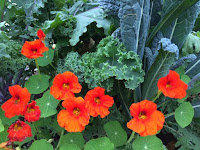When seeds that overwintered in the garden first sprout up, they give clues about the temperature of the soil. If the soil is warm enough to germinate wild dill seeds, for example, it is warm enough for peas, lettuces and kale.
Cilantro
Cilantro or coriander is best picked early, before the plants elongate and the leaves become fine and slender. If left alone, cilantro sends up a bouquet of small white flowers on tall stems. Seeds form soon after. Coriander or cilantro seeds are of a good size, brown, round and hardy. Seeds can be used for coriander spice, but if left on the ground coriander seeds will survive the Alberta winter in the garden and sprout up in spring. Cilantro is easily identified by the strong scent from the leaves.
Dill
When dill plants first sprout up, they lack that great dill flavour - so wait until the dill is about a foot high to harvest. July is a good time to harvest wild dill for fresh use. Later in the season, in late August, dill can get buggy in our garden. Don't let too much dill re-seed, or it will overwhelm the garden. It's a beautiful site in late August, but just leave a few seed heads in the garden.
 |
| Red poppies |
 |
| Poppies |
 |
| Sunflower in early July |
Nasturtuims
Nasturtiums have large seeds that surprisingly can survive winter. Below, they are growing in amongst the kales and garlic. But they do have a strong, large root system and could crowd out other plants so they may need to be culled. The bright blooms are pretty overflowing the edges of a raised bed.
 |
| Nasturtiums beside the kale |
Cherry tomatoes will re-seed but the season is not long enough to produce fruit from them. Oregano, chives and wild green onions will go to seed and new plants will pop up throughout the garden.
Plants that send out new shoots
StrawberriesStrawberries will spread in the garden. The strawberries are easily controlled. They are one of the first plants up in the spring.
Mint
Mint can be dug out if it spreads too far, but a better strategy is to find a place where it will be naturally contained. We have about 8 inches of earth between the garage and a sidewalk. That's where the mint is is planted and confined. It (almost) chokes out the weeds and that is a bonus. Garden mint is hardy and refreshing as tea or in water. Having a bit of mint growing in the garden is a pleasure.
Saskatoons and raspberries will send out underground shoots, which you may or may not appreciate. These can be dug out.
Mint can be dug out if it spreads too far, but a better strategy is to find a place where it will be naturally contained. We have about 8 inches of earth between the garage and a sidewalk. That's where the mint is is planted and confined. It (almost) chokes out the weeds and that is a bonus. Garden mint is hardy and refreshing as tea or in water. Having a bit of mint growing in the garden is a pleasure.
 |
| Mint - spreads rapidly. |
If you leave garlic to flower and seed, small garlic plants will sprout up the following year, but they won't produce big bulbs that season.
Seeds from tomatoes will sprout, but if the tomatoes were hybrids, the fruit will not be the same. The season is too short to get a good crop.
This year a stray turnip appeared in the garden, although we didn't grow any turnips last year.




